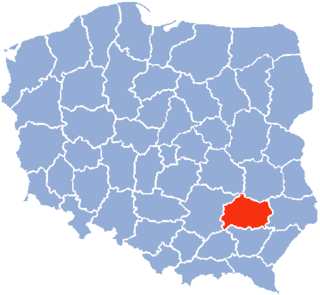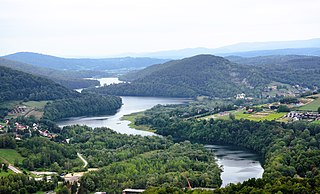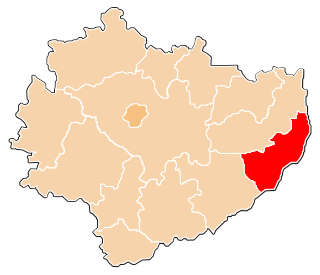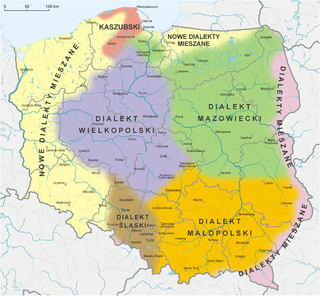
Lesser Poland, often known by its Polish name Małopolska, is a historical region situated in southern and south-eastern Poland. Its capital and largest city is Kraków. Throughout centuries, Lesser Poland developed a separate culture featuring diverse architecture, folk costumes, dances, cuisine, traditions and a rare Lesser Polish dialect. The region is rich in historical landmarks, monuments, castles, natural scenery and UNESCO World Heritage Sites.

The Tarnobrzeg Voivodeship was a unit of administrative division and local government in Poland in years 1975-1998, superseded in parts by Subcarpathian Voivodeship, Świętokrzyskie Voivodeship and Lublin Voivodeship. Its capital city was Tarnobrzeg, although the major city in the region was Stalowa Wola.

Kraśnik is a town in southeastern Poland with 35,602 inhabitants (2012), situated in the Lublin Voivodeship, historic Lesser Poland. It is the seat of Kraśnik County. The town of Kraśnik as it is known today was created in 1975, after the merger of its two districts - Kraśnik Lubelski, and Kraśnik Fabryczny.

Sandomierz is a historic town in south-eastern Poland with 23,863 inhabitants, situated on the Vistula River near its confluence with the San, in the Sandomierz Basin. It has been part of Świętokrzyskie Voivodeship since its transfer from the Tarnobrzeg Voivodeship in 1999. It is the capital of Sandomierz County. Sandomierz is known for its preserved Old Town, a major cultural and tourist attraction which the President of Poland declared a National Monument of Poland in 2017.

Tarnobrzeg is a city in south-eastern Poland, on the east bank of the river Vistula, with 49,419 inhabitants, as of 31 December 2009. Situated in the Subcarpathian Voivodeship since 1999, it had previously been the capital of Tarnobrzeg Voivodeship (1975–1998). Tarnobrzeg lies in the Sandomierz Basin, and directly borders the town of Sandomierz, Świętokrzyskie Voivodeship. Its history dates back to the year 1593, when it was granted Magdeburg rights, and belonged to the Tarnowski family. For centuries Tarnobrzeg remained a small town, which did not develop until the post-World War II period, when it became center of an industrial area, based on rich sulfur deposits.

Stalowa Wola is the largest city and capital of Stalowa Wola County with a population of 58,545 inhabitants, as at 31 December 2021. It is located in southeastern Poland in the Subcarpathian Voivodeship. The city lies in historic Lesser Poland near the confluence of the Vistula and the San rivers, and covers an area of 82.5 km2 (31.9 sq mi).

The San is a river in southeastern Poland and western Ukraine. It is a tributary of the river Vistula. With a length of 458 kilometres (285 mi), the San is the 6th-longest Polish river. It has a basin area of 16,877 km2, of which 14,426 km2 is in Poland.

Niskopronounced[ˈɲiskɔ] is a town in Nisko County, Subcarpathian Voivodeship, Poland on the San River, with a population of 15,048 inhabitants as of 31 December 2021. Together with neighbouring city of Stalowa Wola, Nisko creates a small agglomeration. Nisko has been situated in the Subcarpathian Voivodship since 1999.

The Warsaw subdialect, or Warsaw dialect, is a regional subdialect of the Masovian dialect of the Polish language, centered on the city of Warsaw. It evolved as late as the 18th century, under notable influence of several languages spoken in the city. After the destruction of Warsaw in the aftermath of the Warsaw Uprising of 1944 the subdialect has been in decline. It is estimated that in modern times it is almost extinct as the native language and is preserved mostly in literary works.

Sandomierz Voivodeship was a unit of administration and local government in Poland from the 14th century to the partitions of Poland in 1772–1795. It was part of the Lesser Poland region and the Lesser Poland Province. Originally Sandomierz Voivodeship also covered the area around Lublin, but in 1474 its three eastern counties were organized into Lublin Voivodeship. In the 16th century, it had 374 parishes, 100 towns and 2586 villages. The voivodeship was based on the Sandomerz ziemia, which earlier was the Duchy of Sandomierz. The Duchy of Sandomierz was created in 1138 by King Bolesław III Wrymouth, who in his testament divided Poland into five principalities. One of them, with the capital at Sandomierz, was assigned to Krzywousty's son, Henry of Sandomierz. Later on, with southern part of the Seniorate Province, the Duchy of Sandomierz created Lesser Poland, divided into Kraków and Sandomierz Voivodeships.
The Central Industrial District, is an industrial region in Poland. It was one of the biggest economic projects of the Second Polish Republic. The 5-year-long project was initiated by a famous Polish economist, deputy Prime Minister and Minister of the Treasury, Eugeniusz Kwiatkowski. Its goal was to create a heavy industrial center in the middle of the country, as far as possible from any borders, strengthen the Polish economy and reduce unemployment. The four-year plan for the development of COP was scheduled from 1 September 1936 until 30 July 1940 and was interrupted by the outbreak of the Second World War and the German invasion of Poland on 1 September 1939. Nonetheless, the COP project succeeded in vastly expanding Polish industry, and after the end of the war in 1945 COP was rebuilt and expanded under the People's Republic of Poland.

The Gorals, also known as the Highlanders are an ethnographic subgroup primarily found in their traditional area of southern Poland, northern Slovakia, and in the region of Cieszyn Silesia in the Czech Republic, where they are known as the Silesian Gorals. There is also a significant Goral diaspora in the area of Bukovina in western Ukraine and in northern Romania, as well as in Chicago, the seat of the Polish Highlanders Alliance of North America.

Sandomierz County is a unit of territorial administration and local government (powiat) in Świętokrzyskie Voivodeship, south-central Poland. It came into being on January 1, 1999, as a result of the Polish local government reforms passed in 1998. Its administrative seat and largest town is Sandomierz, which lies 83 kilometres (52 mi) east of the regional capital Kielce. The county also contains the towns of Koprzywnica, lying 16 km (10 mi) south-west of Sandomierz, and Zawichost, 16 km (10 mi) north-east of Sandomierz.

Polish dialects are regional vernacular varieties of the Polish language.

Sandomierz Basin is a lowland, located in southeastern Poland, between the Lesser Poland Upland, Lublin Upland and the Western Carpathians. Its name comes from the historical city of Sandomierz, and the basin has a triangular shape with the size of around 15,000 km2 (5,800 sq mi). It is drained by the Vistula River, as well as its eastern tributary, the San. Among major cities located in the Sandomierz Basin are Dębica, Jarosław, Mielec, Przemyśl, Przeworsk, Rzeszów, Stalowa Wola, Sandomierz, Tarnobrzeg, and Tarnów.

Sandomierz Forest is one of the biggest forests in southern Poland; covering large parts of the Sandomierz Basin. Its name comes from the historical city of Sandomierz, and in the Middle Ages its eastern edge created a natural border between Lesser Poland and Red Ruthenia.

Radomyśl nad Sanem is a village in Stalowa Wola County, Subcarpathian Voivodeship, in south-eastern Poland. It is the seat of the gmina called Gmina Radomyśl nad Sanem. It lies on the San river in Lesser Poland, approximately 14 kilometres (9 mi) north-west of Stalowa Wola and 73 km (45 mi) north of the regional capital Rzeszów. Radomyśl was a town from 1558 to 1935.

Sztafeta is a 1939 compendium of literary reportage written by Melchior Wańkowicz. It was published in the year of the German-Soviet invasion of Poland. Popular demand caused it to be reprinted four times by the Biblioteka Polska before the outbreak of hostilities. The book was never published in Communist Poland because it praised the democratic achievements of the prewar Second Polish Republic.
The Lublinians are a subethnic group of the Polish people, who reside in the historic region of Lesser Poland, in the area of the city of Lublin. They use their own dialect, which belongs to the Lesser Poland dialect of the Polish language. Like most Poles, the Lubliniacy are Roman Catholics.
The Sandomierzacy are a ethnographic group of the Polish nation, who reside in the historic province of Lesser Poland, around the town of Sandomierz. They use their own dialect, which belongs to Lesser Polish dialect of the Polish language. Like most Poles, the Sandomierzacy are Roman Catholics.


















